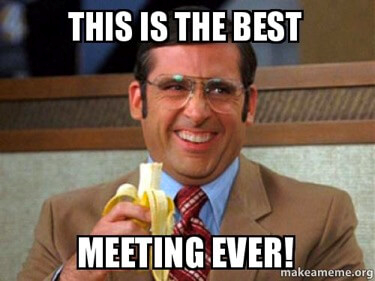A 1:1 meeting is an effective instrument to forge strong manager-employee relationships through open communication. In this article, we will explain how we understand the concept of 1:1 meetings here at ORIL. We will look at how to arrange and make use of this event to provide helpful insight into the employee experience within the company, discuss career opportunities, or get a pulse on job satisfaction.
Why 1:1 Meetings Are Important
Undoubtedly, employee-focused meetings are essential because they lay the foundation for trusting and productive work relationships within the team and the company in general. So, a 1:1 meeting is a practical instrument for both participants since it allows:
- To build trust and establish more open interpersonal relationships.
- To align goals and expectations regarding workflows.
- To provide and get feedback.
- To create a favorable environment for professional growth and success.
- To look at the company and its corporate processes from different angles.
- To spot and handle issues, bottlenecks, blocks, or conflicts.
- To streamline workflows in the condition of remote work.
- To ensure a smooth onboarding to help newcomers better understand the internal workflows and get to work within the shortest time.
Streamlined Remote Work
They had become especially critical when companies moved to a fully remote working mode. It’s not a secret that remote work has perks and challenges, so carrying 1:1 meetings helps remote employees stay focused, motivated, and in the loop of internal company processes.
Better Communication
1:1 meetings are dynamic rather than cast in stone. And that’s the way it should always go. Hence, there is always a need for more effective tools of communication between a manager and an employee. 1:1s are a perfect fit for this purpose.
Smooth Onboarding
When the team is constantly growing, there is an increased need for more personalized onboarding. So, 1:1 meetings help newcomers better understand the internal workflows and get to work within the shortest time.
Open Dialog
Sometimes there is a lack of feedback from the team members about the performance of the manager or the whole company. So a 1:1 session can become an essential part of the ongoing performance management process to remove the communication gap and arrange a two-dimensional dialog between the parties.
Understanding A One-on-One Meeting
A 1:1 meeting looks like an easy thing, but there is still confusion among managers and employees. In this section, we would like to explain how ORIL defines this event.
| Don’t Confuse! This Is Not 1:1 |
| ❌not a status meeting to discuss current tasks’ results |
| ❌not a friendly talk over a cup of coffee |
| ❌not organized to reprimand the employee |
| ❌not a 1:0 or 0:1 meeting where one person dominates over another |
| ❌not about salary review only |
What Is a 1:1 Meeting?
So, a 1:1 meeting is a sort of check-in between two people in the organization (usually a manager who works closely with an employee and a team member). It is used to provide feedback, keep each other updated, address issues, and assist the participants in advancing in their roles. This type of conversation has specific characteristics, which include:
✅It’s formal.
✅It’s scheduled in advance.
✅It’s regular.
✅It requires preparation from both participants.
✅It involves noting down insights.
✅It includes action items, which should be implemented after the meeting.

So, in other words, a 1:1 is an official, scheduled meeting that occurs regularly and has action items to reach better efficiency and performance.
At the same time, we define 1:1s as a strategy of feedback exchange and the core element of the ORIL corporate culture. It’s a brick that allows all company members and the company in general effectively tackle tasks and become more effective. These meetings are essential for the continuous company development and the growth of every team member.
These meetings should always be actionable. Communication for the sake of communication is not what 1:1s involve. So, after the meeting, both parties should be ready to work on action items to achieve the desired result. After all, the effective 1:1 meeting strategy should look like this:

Behind the Scenes of a 1:1 Meeting: Who, When, How
Usually, a project manager or a team manager holds a meeting. In some cases, it can be carried out by CEO or CTO. Why not an HR manager? Because a project or team manager works with you closely and knows the situation much better. They can track the changes or your progress and notice nuances in your work others won’t track, so they will generate more constructive and detailed feedback.
Some resources suggest that 1:1 meetings should be arranged weekly or at least once a week. At ORIL, we view 1:1s as a process, so usually, they happen once in 2 or 3 months. That’s the frequency that we find the most optimal for our team.
Every manager has a calendar with pre-scheduled meetings for every staff member. However, the appointed time and date are not cast in stone and can be negotiated to ensure every meeting participant is in a good mood, health, and is open for communication.
Signs of An Ineffective 1:1 Meeting You Could Have Missed
Even though your 1:1 meeting may have all the attributes mentioned above, it doesn’t mean that it is destined for success. Here is a list of things that may lead to the meeting failure:
❌It’s carried for show.
❌It strictly follows the template.
❌It’s reluctant and free of enthusiasm.
❌Only one person is engaged or interested in the conversation.
❌It lacks mutual trust.
❌It’s spontaneous and held without preliminary preparation.
❌It doesn’t involve action items.
❌One or both participants do not grasp the goal of the meeting.
Tips on How to Run an Effective 1:1 Meeting
1. Do your Homework and Get Ready for The Meeting
Here are a few tips on how to be ready for the 1:1 meetings.
- Review notes and action items from the previous meeting.
- Look through the 1:1 meeting agenda.
- Get ready to provide feedback about the work of a manager, the company in general, the project, or processes within the team.
- Make sure you are mentally and physically ready for the meeting.
2. Make Notes Before, During, and After the Meeting
It’s important to make notes throughout the whole work period if you have any items for discussion, not just before the meeting. This way, you ensure you do not miss a thing and go over critical questions.
At ORIL, we have a file for every employee that allows them to note down information before, during, and after the meeting. Here is what it looks like.

We use it to summarize the feedback-sharing process and keep track of the progress. That’s also where we finalize the meeting by filling in action items.
3. Make Sure Your Know What to Expect from Your 1:1
Although 1:1s are about live communication, they still have a template with a defined agenda. The points can be changed, or you can add extra issues for discussion. So, here is how your 1:1 meeting can be structured:
- A small talk to warm up the conversation
- Providing feedback:
- Project & work performance
- Personal growth
- Team & management
- Company and work environment
- Receiving feedback
- Negotiating the list of action items

4. Be Physically and Mentally Ready for Your Meeting
It’s also essential to be physically and mentally ready for the meeting. Therefore,
- Make sure you have enough sleep before the meeting and that you are in good health.
- Create a favorable atmosphere for sharing feedback – ensure nothing distracts you from the conversation.
- Practice active listening, set eye contact, and use open body language.
- Keep in mind that this is a dialog. Do not take the defensive position and be open to any feedback.
5. Steel Yourself for Delivering Feedback
- If you are going to have a first 1:1 meeting or would like to improve your feedback-sharing skills, here are a few tips to help you get ready for this process:
- Think about things that motivate you in your work. Explain why.
Are there things that annoy or demotivate you? - How do you see your professional growth?
What do you believe is your biggest disadvantage? What can you do about this to change the situation? - What do you like about the company? What are you grateful for? What do you appreciate most in the manager’s work?
What makes you feel uncomfortable in the company?
Also, get ready a few questions for the manager to better understand where your effort should go. For example, you can ask your manager whether they see a hidden potential in you to become, for example, a team lead or advance to other positions.
| Important! |
Give feedback from the perspective of:
|
6. Make Your Meetings Actionable
Every meeting should end with setting action items. An action item is a discrete task that must be accomplished. They can be assigned to the employee, manager, or company to ensure positive progress is noticeable between the meetings.
| Important! |
| The action item should be specific (you can use the SMART goal-setting technique) and achievable. |
| It will also be good to complete it before the next meeting. |

7. Get Prepared for a Salary Review (If It’s Outlined in the Agenda)
If the 1:1 meeting will include a salary review, make sure you analyze:
- Results from the previous action item list.
- Your achievements and accomplishments. Be especially mindful of the ones that delivered the most value to the team and company.
8. Carry 1:1 Meetings Regularly
It’s important to make 1:1 meetings regular. Usually, a manager is responsible for scheduling 1:1 meetings, but you can always discuss this issue if the pace of the meetings is inconvenient for you. Also, make sure you do not skip these meetings. If it happens that the time or date is not appropriate for you, just ask to reschedule it.
- Meetings scheduled too often won’t let you complete action items or get used to the changes in your workflows if any have been established after the meeting.
- Meetings arranged far apart make it challenging to build momentum and may encourage procrastination.
- Meetings without a specified frequency do not promote establishing a system within the company and make the progress nearly irrelevant.

9. Improve Your Listening Skills
Listening skills are equally important for managers and employees during 1:1s. It is a useful skill that will help you receive feedback or get a piece of advice. The better you listen to your manager, the more efficient the meeting will be.
- You will grasp the right insights from your manager’s feedback.
- You will implement action items more consciously and with a focus on a positive result.
- You will learn and grow.
Wrapping It Up
A 1:1 meeting is a helpful practice that enables maintaining the right spirit in the company, making sure all employees are on the same page, promoting professional growth, and ensuring everyone works effectively.
You should not take these meetings lightly as they take a formal format and have a regular nature. Therefore, getting ready for 1:1 is as essential as preparing yourself for a new job interview.






